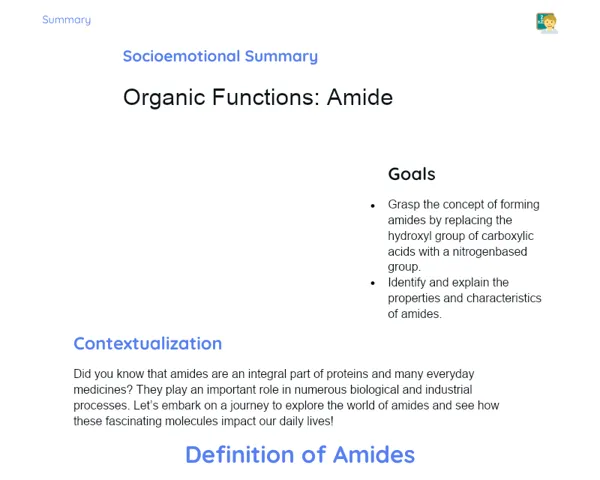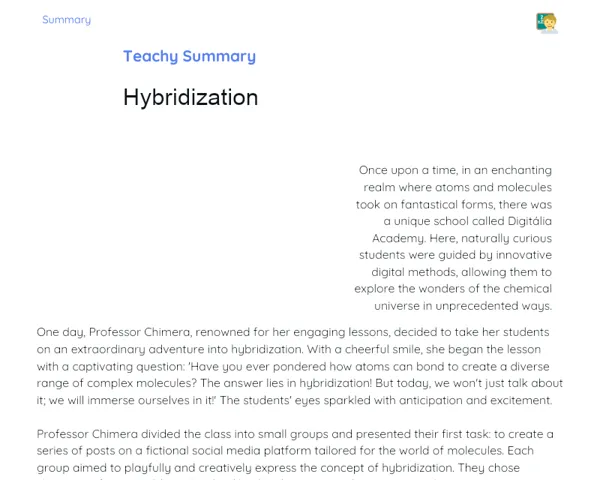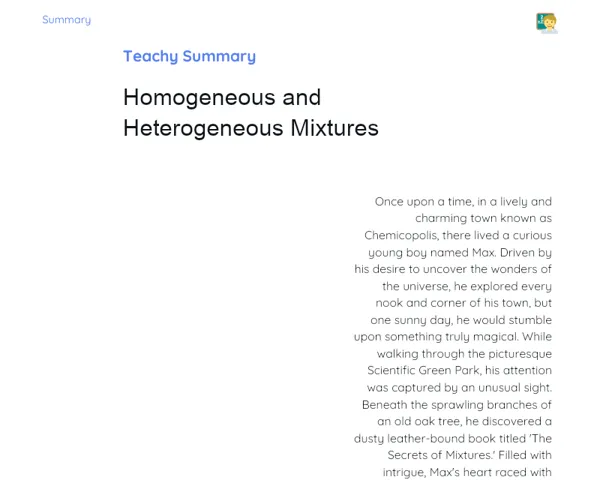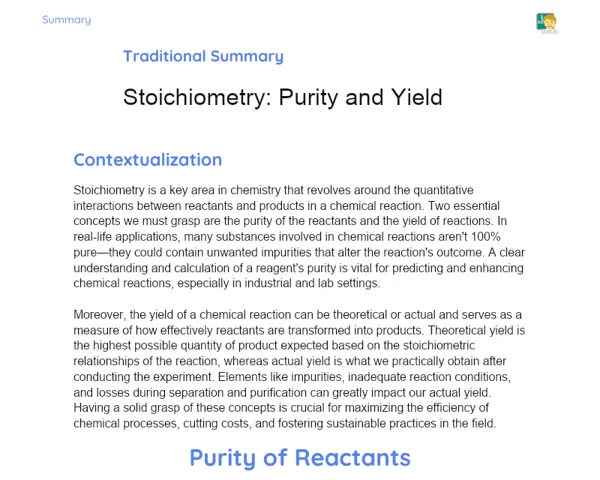Summary Tradisional | Nuclear Reaction: Activity
Contextualization
Nuclear reactions happen in the nucleus of atoms and play a significant role across various scientific and technological fields. The activity of a radioactive sample indicates how quickly the unstable nuclei within it decay. This measurement is vital for grasping and applying the principles of nuclear chemistry. The relevance of this concept extends beyond just the realm of science; it has practical implications in areas like medicine, energy production, and archaeology.
Radioactive activity is quantified in becquerels (Bq), where one becquerel signifies one disintegration each second. Being able to calculate and monitor this activity is essential for scientists and technicians to handle radioactive materials safely and efficiently. For instance, in the medical field, gauging radioactive activity is crucial for cancer treatments involving radiotherapy. In archaeology, it allows for accurate dating of fossils and ancient relics through radiocarbon dating.
To Remember!
Definition of Radioactive Activity
Radioactive activity measures how quickly the unstable nuclei in a sample decay. It is denoted in becquerels (Bq), where one becquerel indicates one disintegration per second. This understanding is crucial for many practical scenarios.
The activity of a sample relies directly on the count of unstable nuclei it contains and the decay constant specific to the radioactive isotope. This decay constant is unique for each isotope and dictates the rate of disintegration of the nuclei. The relationship is represented by the formula A = λN, where A is the activity, λ is the decay constant, and N signifies the number of unstable nuclei.
Grasping this relationship allows scientists to predict how radioactive materials behave and apply these insights for safe usage. For instance, in medical treatments, knowing the activity of the radioactive substance is vital to administer the correct dosage to patients. In environmental studies, monitoring radioactive activity helps gauge risks and implement effective measures for prevention.
-
Activity is measured in becquerels (Bq).
-
The basic formula is A = λN.
-
The decay constant (λ) is specific to each isotope.
Radioactive Decay Law
The Radioactive Decay Law explains how the activity of a radioactive sample reduces over time. It is articulated with the formula A = A₀e^(-λt), where A represents the activity at time t, A₀ is the initial activity, λ is the decay constant, and t is the time elapsed. This equation illustrates that activity decreases exponentially as time moves forward.
The decay constant (λ) is a key component in this equation, determining the velocity of activity decline. A higher decay constant means a quicker disintegration rate. Familiarity with this law is imperative for predicting how radioactive materials behave in various circumstances, whether it's nuclear waste management or medical applications.
Additionally, this law serves as a foundation for dating materials from the past, like fossils and archaeological artifacts. By assessing the residual radioactive isotopes in a sample and applying the decay law, scientists can estimate the material's age. This approach is particularly prevalent in radiocarbon dating, which accurately discerns the age of organic substances.
-
The Radioactive Decay Law is expressed as A = A₀e^(-λt).
-
Activity decreases exponentially over time.
-
The decay constant (λ) is crucial for determining the rate of decay.
Half-Life
The half-life of a radioactive isotope is the duration needed for half of the unstable nuclei in a sample to decay. This provides a practical way to gauge the decay rate of a radioactive substance and indicates the stability and durability of isotopes. Every isotope possesses a unique half-life, which can span from mere fractions of a second to billions of years.
The half-life is inversely proportional to the decay constant (λ), and the relationship is calculated using the formula T₁/₂ = ln(2) / λ. This makes it handy for transitioning between decay constant and half-life depending on the scenario. For instance, in nuclear medicine, understanding an isotope's half-life is essential for treatment planning and ensuring patient safety.
Furthermore, half-life is a core concept in radiocarbon dating. Scientists evaluate the remaining Carbon-14 (a radioactive isotope) in a sample to ascertain its age. Since Carbon-14 has a half-life of about 5730 years, this method becomes effective for dating organic specimens up to roughly 50,000 years.
-
The half-life is the time needed for half of the unstable nuclei to decay.
-
The formula for half-life is T₁/₂ = ln(2) / λ.
-
Knowledge of half-life is critical for applications in nuclear medicine and antique dating.
Calculating Activity
To calculate the activity of a radioactive sample, we apply the formula A = λN, where A is the activity, λ is the decay constant, and N is the count of unstable nuclei. This calculation underpins various practical uses, encompassing medical diagnostics, environmental risk analysis, and archaeological dating.
To execute these calculations, knowing the decay constant for the isotope in question is essential. Often, this constant can be acquired from the isotope’s half-life using λ = ln(2) / T₁/₂. Once the decay constant is established, you can find the activity by multiplying the number of unstable nuclei by this constant.
For tangible examples, these calculations could determine the radiation dosage necessary for treating a cancerous tumor in radiotherapy or evaluate the activity of radioactive pollutants in environmental studies. Such calculations allow scientists and technicians to securely monitor and utilize radioactive materials, thus safeguarding human health and the environment.
-
The formula to calculate activity is A = λN.
-
The decay constant can be ascertained from the half-life.
-
Calculating activity is essential for medical, environmental, and archaeological purposes.
Key Terms
-
Radioactive Activity: Measure of the decay rate of unstable nuclei in a sample, articulated in becquerels (Bq).
-
Nuclear Decay: The process wherein an unstable nucleus releases energy by emitting radiation.
-
Becquerels (Bq): Measurement unit for radioactive activity, equivalent to one disintegration per second.
-
Radioactive Decay Law: Formula outlining the exponential decline of the activity of a radioactive sample over time.
-
Half-Life: Duration required for half of the unstable nuclei in a sample to decay.
-
Decay Constant (λ): Parameter dictating how fast a radioactive isotope disintegrates.
-
Activity Calculation: Utilization of the formula A = λN to ascertain the activity of a radioactive sample.
-
Nuclear Medicine: Medicine branch employing radioactive materials for diagnosing and treating illnesses.
-
Radiocarbon Dating: Method for dating organic substances based on measuring residual Carbon-14.
-
Nuclear Energy Generation: Creation of electrical energy from controlled nuclear reactions.
Important Conclusions
The radioactive activity of a sample is a vital measure indicating the decay rate of the unstable nuclei within, expressed in becquerels (Bq). Understanding and calculating this activity is key for practical applications like nuclear medicine for cancer therapy, archaeology for dating fossils and ancient relics, and nuclear energy production. The Radioactive Decay Law and half-life are critical for foreseeing how radioactive materials behave and ensuring their safe and effective usage.
In our lesson, we examined the fundamental formula A = λN connecting activity (A), decay constant (λ), and the number of unstable nuclei (N). Additionally, we discussed how to derive the decay constant from the isotope's half-life. These calculations are instrumental in securely overseeing and using radioactive substances, protecting both human health and the environment.
The knowledge gained regarding radioactive activity and its computations empowers students to appreciate radioactivity's relevance in daily life and science. It is an important topic that impacts critical sectors such as medicine, archaeology, and energy. We encourage students to further explore this subject, enhancing their knowledge and recognizing the significance of nuclear chemistry across various aspects of society.
Study Tips
-
Review half-life and decay constant concepts, tackling practical problems involving these calculations.
-
Research applications of radioactivity in medicine and archaeology to comprehend the practical implications of theoretical knowledge.
-
Utilize simulators and educational tools to visualize radioactive decay and compute the activity of specified samples.



